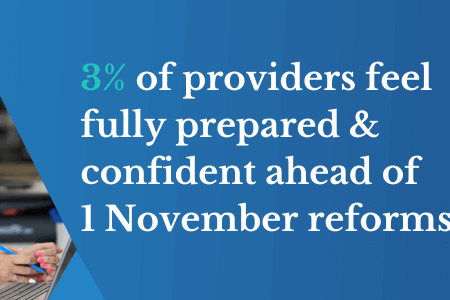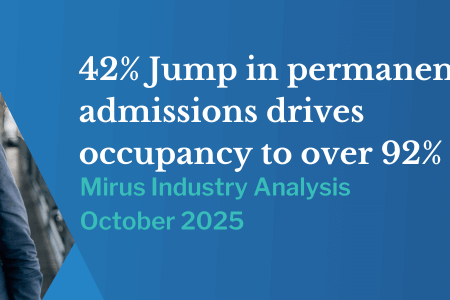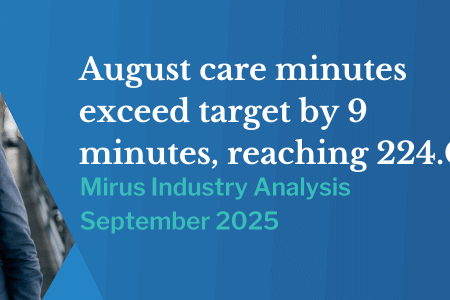Understanding the Care Minute Performance Statement. Is your auditor ready?
November 26, 2025 | Care Minutes

As the expectations for transparency and workforce accountability continue to strengthen across residential aged care, the Care Minute Performance Statement (CMPS) is becoming a core element of provider reporting. While most organisations have already embedded processes for monitoring care minutes, many are now turning their attention to what needs to be formally declared, by when, and who is best placed to complete the assurance work.
What is the Care Minute Performance Statement?
The Care Minute Performance Statement is a new annual declaration required under the strengthened framework for workforce and care reporting. It aims to provide a clear, standardised view of how each provider has performed against their mandated care minute responsibilities—both at the facility level and on average across the year.
The statement will typically include:
- Total care minutes delivered per resident per day (RN/EN/AIN/PCW).
- Average care minutes delivered over the reporting period.
- Comparison to the mandated target minutes for each service.
- Explanations for material variances and the actions taken to address shortfalls, if any.
- Any relevant contextual workforce information, including reliance on agency staff where required.
This ensures transparency not only for the regulator, but for consumers, families, staff and Boards charged with oversight of workforce planning and care delivery.
What is required — and by when?
Providers will need to prepare and lodge the Care Minute Performance Statement as part of their annual reporting cycle. While the exact deadline is aligned with the broader Annual Financial Report to the Department, the CMPS effectively becomes another regulated assurance requirement.
Key expectations include:
1. Accurate and complete data capture
Providers must ensure that all shifts, classifications, and FTE allocations contributing to direct care are correctly recorded. This includes distinguishing between:
- Direct vs indirect care minutes
- RN vs non-RN minutes
- Agency vs employed hours
2. Reconciliation between roster, time and attendance, and payroll
The regulator expects a clear audit trail. Minutes reported must be reconcilable to underlying systems — something many providers are already improving through automation and integrated solutions.
3. A signed declaration
The Care Minute Performance Statement must be signed by the governing body or delegated authority to attest that:
- The information is true and correct
- Care minute obligations have been met (or reasonable steps were taken)
- Variances are properly explained
4. Assurance from an approved auditor
The CMPS must be reviewed and assured by an eligible auditor with the appropriate qualifications and independence.
Most providers will need to complete this work in line with their annual reporting and audit cycle, typically between July and October each year, depending on internal timelines and external auditor availability.
Can your current auditor undertake this work?
In most cases, yes — but not always.
Providing assurance over the Care Minute Performance Statement requires a combination of:
- Financial audit capability
- Workforce and payroll systems understanding
- Compliance experience in aged care
Here are some practical considerations when assessing whether your auditor is suitable:
1. Eligibility and accreditation
Your auditor must meet the independence and professional accreditation requirements already established for financial reporting. Not all auditors currently servicing aged care providers offer assurance over non-financial workforce metrics.
2. Understanding of AN-ACC and care minute rules
Assuring the CMPS is not just a reconciliation exercise. Auditors need to understand:
- Who counts as “direct care”
- How minutes are classified
- How target minutes are applied across different AN-ACC classes
- What constitutes a valid variance explanation
If your auditor has limited exposure to the new care minute framework, they may need additional training or support.
3. Systems and data expertise
Auditors must be comfortable auditing:
- Rostering platforms
- Time and attendance systems
- Payroll data
- Agency provider reporting
If your systems are complex or you operate multiple homes, you may need an auditor with specialist experience.
4. Independence from advisory or systems implementation work
If your auditor has recently provided advisory, implementation, or care minute optimisation services, they may not meet independence requirements to sign off the CMPS.
5. Capacity
The introduction of the CMPS increases the workload for audit firms at a time of year when capacity is already stretched. Some firms may prioritise existing financial audit obligations and decline additional assurance work.
What should providers do now?
1. Confirm your auditor’s eligibility early
Reach out now to confirm whether your existing auditor:
- Is willing and able to perform the CMPS assurance
- Has capacity in the appropriate timeframe
- Meets independence requirements
2. Strengthen your data and processes
Ensure your care minute reporting is:
- Systemised, not spreadsheet-driven
- Reconciled fortnightly
- Backed by supporting documentation
- Able to be easily extracted and shared
3. Consider a specialist provider
If your current auditor cannot undertake the CMPS, you may need a specialised aged care assurance partner with experience in workforce, systems and AN-ACC. Mirus Australia is building a network of assurance partnerships to help.
4. Plan the timeline
Add the CMPS to your annual reporting calendar to avoid a last-minute rush. Internal teams should know:
- When the data will be compiled
- When draft documentation is due
- When the auditor needs access
Final thoughts
The Care Minute Performance Statement is more than a compliance requirement—it’s an opportunity for providers to bring confidence and clarity to one of the sector’s most scrutinised areas. With the right preparation, strong data foundations and early engagement with your auditor, the process can be a straightforward part of your annual reporting cycle.
If you’d like help reviewing your care minute reporting processes, getting a system that takes the guess work out, or preparing for the assurance requirements, we’re here to support you.


